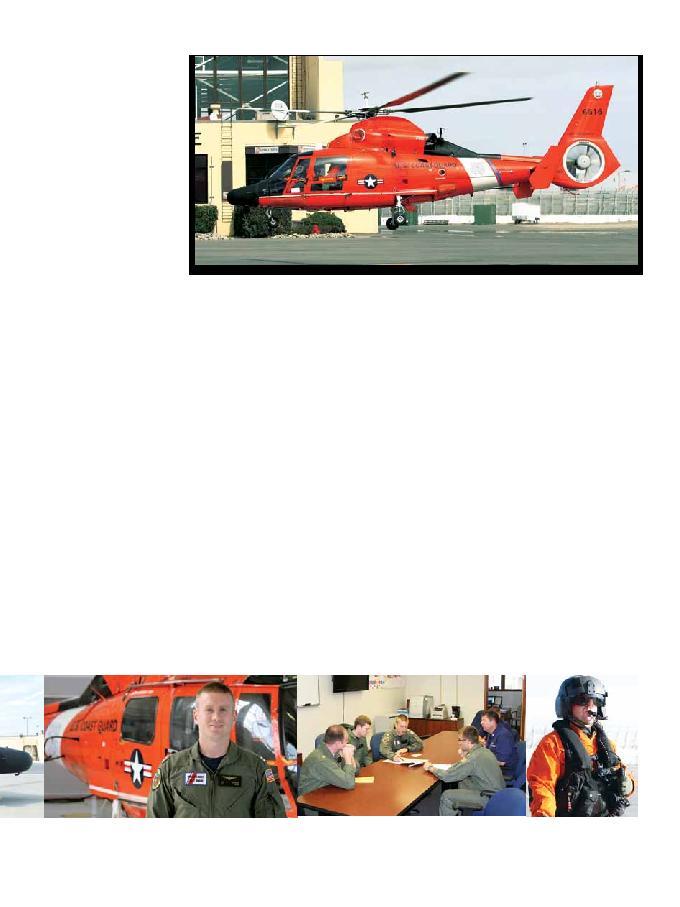
2013 FEBRUARY / Vol. 5 / No. 2 /
GA
37
T
he U.S. Coast Guard Air
Station San Francisco, co-
located at the San Francisco
International Airport in San
Francisco, California, is one of four
air stations in the Coast Guard's 11th
District which encompasses the states
of California, Arizona, Nevada and
Utah, the coastal and offshore waters
of more than one thousand miles and
the offshore waters of Mexico and
Central America extending to South
America. The Coast Guard's 11th
District operational units are located
throughout the state of California, with
the District and Pacific Area headquar-
ters located on Coast Guard Island in
Alameda, California, along the eastern
side of San Francisco Bay. Most of Air
Station San Francisco's operations are
conducted in the San Francisco Bay
area and the Sacramento River delta.
The Coast Guard is one of five armed
forces of the United States and the
only military organization within the
Department of Homeland Security.
Previously, the Coast Guard oper-
ated as part of the Department of
Transportation. The attacks of 9/11
served as a catalyst for the transition
to Homeland Security. The Coast
Guard officially became part of the
Department of Homeland Security
in 2003, further expanding the role
of the aviation units beyond Search
and Rescue duties. The passing of
the Homeland Security Act in 2002
brought increased emphasis on the
maritime security role. The Coast
Guard is responsible for conducting
security patrols over America's major
maritime infrastructure. For the Air
Station at San Francisco, this includes
the enormous port facilities at San
Francisco and Oakland, along with
the waterways which lead inland to
Stockton and Sacramento.
By law, the Coast Guard has eleven
missions to support: Ports, waterways
and coastal security, drug interdic-
tion, aids to navigation, search and
rescue, living marine resources,
marine safety, defense readiness,
migrant interdiction, marine envi-
ronmental protection, ice operations
missions/and law enforcement.
Air Station San Francisco operates
four MH-65C Dolphin helicopters,
which are used to carry out their
search and rescue mission. These
helicopters allow the unit to provide
coverage along 300 miles of coastline
from Point Lucia, located south of
Big Sur (CA), to Point Arena to the
north.
The history of Coast Guard Air
Station San Francisco dates back to
1941, when the unit was established.
The construction of the station was
completed on February 15, 1941. The
first aircraft employed by the station
was a PBY-5 Catalina and two RD-4
Dolphins. On November 1, 1941, the
station's aircraft and personnel were
placed under the command of the
U.S. Navy, where they continued to
conduct search and rescue and coastal
patrols missions through the end of
World War II. The air station resumed
normal operations under Coast Guard
command after release from the Navy
on June 30, 1946.
The first helicopter stationed in San
Francisco was the HO3S-1 Drag-
onfly in 1947. In the early 1950s,
the Grumman HU-16E Albatross
replaced the air station's aging WWII
fixed-wing inventory. This general
purpose amphibian aircraft proved
to be a highly adaptable platform
for search and rescue missions. The
Air Station received the HH-52A
Sea Guard helicopter in 1963, which
was a significant improvement over
its predecessor with improved flight
characteristics and capabilities.
In 1978, the station's C-130s were
relocated to the newly-constructed
Coast Guard Air Station Sacramento,
ending 37 years of Coast Guard
fixed-wing aviation in San Francisco.
In 1991, Air Station San Francisco
received its first HH-60 Jay Hawk to
replace the H-3 Pelican as the medi-
um-range search and rescue helicop-
ter. Aviation restructuring throughout
the Coast Guard meant a short stay
for the HH-60 in San Francisco; in
June 1996, four HH-65s were moved
to San Francisco from San Diego.
In autumn of 2001, the air station
transitioned to the HH-65B, with an
upgrade in the avionics package. In
the spring of 2006, the HH-65B was
upgraded to the HH-65C after the
installation of new Turbomeca Ariel
2C2-CG engines.
The MH-65 Dolphin has been in
the Coast Guard's inventory since
1984, where it is expected to remain
in service through 2027. The Coast
Guard is upgrading the helicopters
with state-of-the-art enhancements
that will extend mission capabili-
ties and improve their reliability and
maintainability.
"With the introduction of the MH-
65D, we are using the latest in tech-
nology," said LT Ian Culver, a pilot
based at Air Station San Francisco.
"The conversion to the MH-65D
will be completed during one flight,
mainly focusing on the new avion-
ics package. The transition to the
MH-65D will be mostly completed by
visiting personnel from the Aviation
Training Center in Mobile, Alabama.
Remaining aircrew members will
be trained by unit instructors" said
Culver.
The conversion and sustainment
project is modernizing the aging
helicopters with digital technol-
ogy. The upgrades include GPS and
inertial navigation, as well as updated
cockpit instrumentation. The MH-65
conversion and sustainment project is
accomplished in six phases or com-
plementary discrete segments. The
Coast Guard upgrades the aircraft
at the Aviation Logistics Center in
Elizabeth City, North Carolina.
Coast Guard Air Station Atlantic City
(N.J), maintains the Coast Guard's
largest MH-65D fleet, with ten re-
cently updated MH-65Ds, which are
1. USCG crews operating the MH-65C consists of a pilot, co pilot, rescue swimmer and a mechanic. 2. LT Ian Culver is one of the pilots attached to the USCG unit at San
Francisco. He has about 1000 hours of flight time in military aircraft and has been flying for nearly 5 years (including flight school). 3. Every flight is prepared in detail during a
pre flight hazardous check. 4. Crew member preparing for another sortie over the San Francisco Bay area.
Special paint is rather unique to be seen on USCG helicopters. During August 2011 one of the unit's
MH-65s was stationed in the Arctic.
2.
3.
4.

